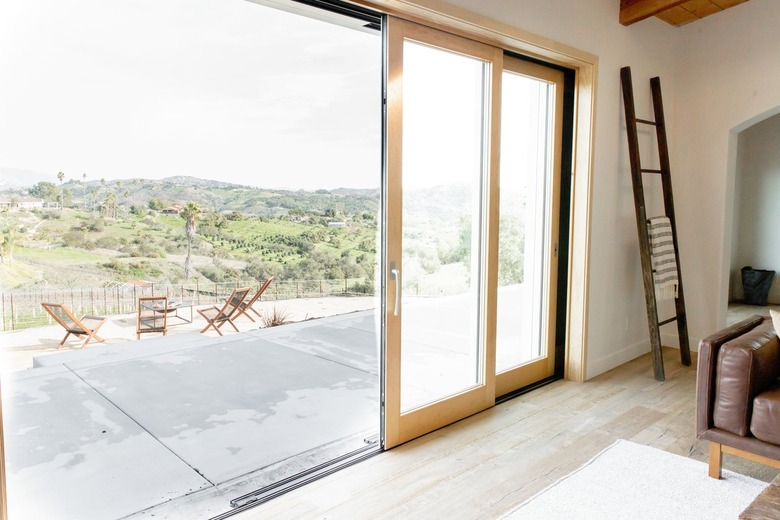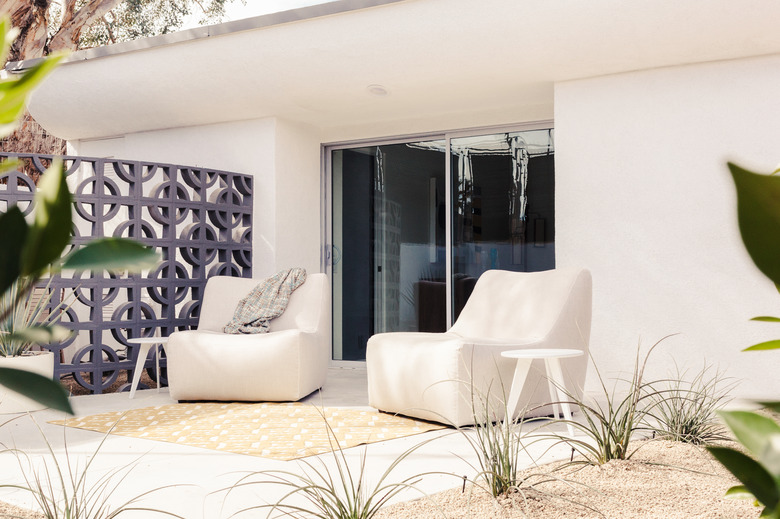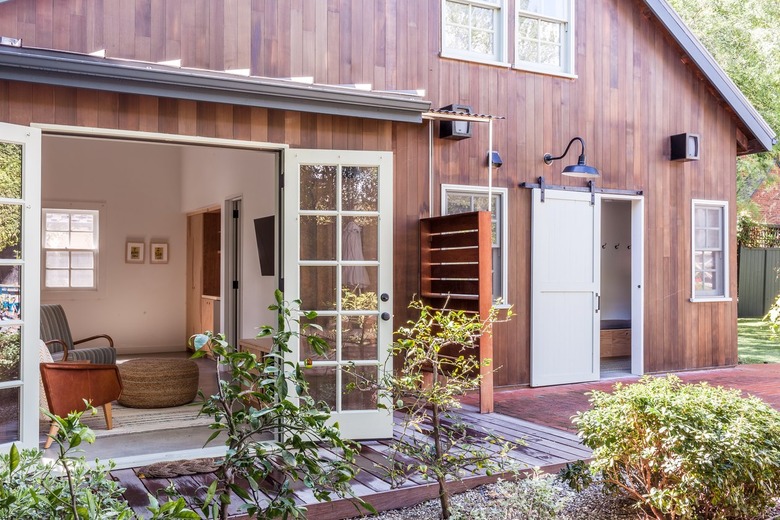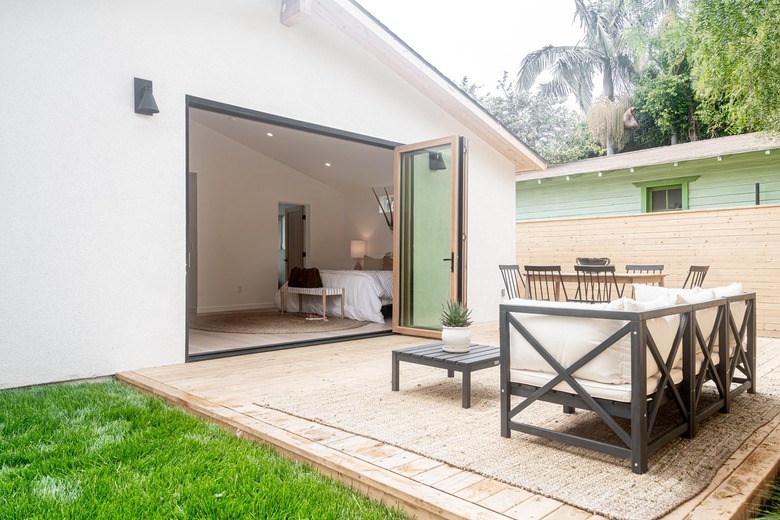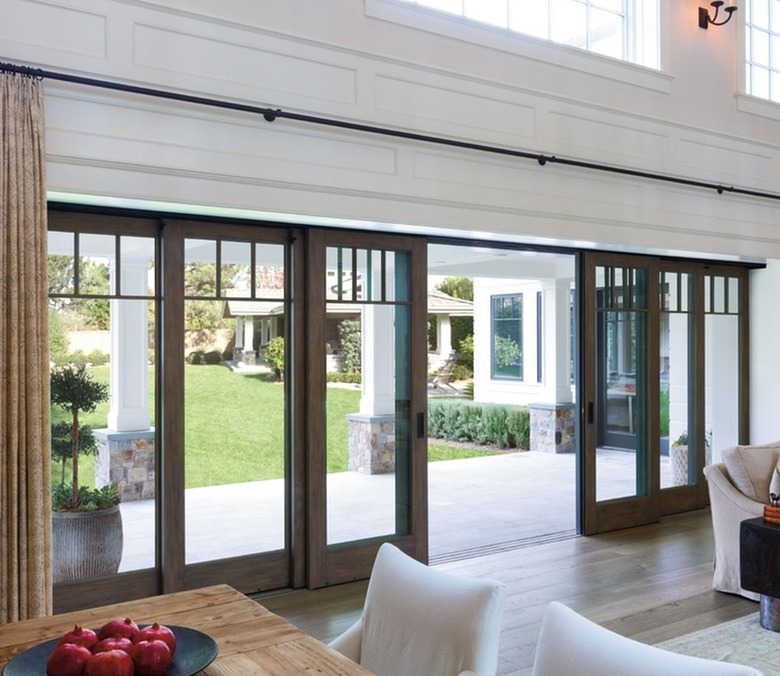The 4 Best Types Of Patio Doors For Breezy Indoor/Outdoor Living
We may receive a commission on purchases made from links.
A patio door provides more than just accessibility to the backyard or outdoor space — it also streams in natural sunlight and adds a dash of style to a living/dining space. Whether you're adding a door to the backyard for the first time or replacing an existing one, there are a few types of patio doors to choose from, all with their own distinct list of pros and cons.
Comparing the types of doors, features of each type, and installation limitations can help you determine which style best fits your home and gives you the look, ease of use, and security you want.
Types of Patio Doors: Considerations
Types of Patio Doors: Considerations
When comparing types of patio doors, looking at key features helps you evaluate which would be best for your space. In other words: The best patio door for one space won't necessarily even fit another. Some of the factors to consider when comparing include:
- Space: How the door opens affects how much space it requires. Doors that swing or fold inward or outward need a more spacious room to accommodate the swing.
- Thermal performance: The opening mechanism can affect the energy efficiency of patio doors. Looking at the National Fenestration Rating Council label for each door you're considering shows you things
to evaluate its performance, like the U-factor (how well the window insulates) and air leakage. - Security: French doors tend to be the most secure option because they're set within a frame and have secure locking functions. However, other types of patio doors also have secure locking systems and can be upgraded to burglar-proof your door.
- Cost: You'll find a variety of prices in all door types, but some types of patio doors are generally more expensive than others. Standard sliding patio doors tend to be the most affordable option, while telescoping or large bifold doors are often more expensive.
1. Standard Sliding Glass Patio Doors
1. Standard Sliding Glass Patio Doors
Sliding glass doors are that classic patio door option you often find in many homes and apartments. And, in fact, they're often the standard option installed by builders. The typical setup features two panels of glass: one that's stationary and one that slides along a track. While you can often reverse the doors to open on the opposite side, the configuration is fairly rigid without any flexibility in how you use the door.
Sliding glass doors present some security risks since the large panes of glass are relatively easy to break. They also do not typically have the strongest locking mechanisms, usually using a latch-style lock instead of a deadbolt like standard swinging doors use. Simple ways to improve the security include adding the following:
- A security bar in the track to keep the door from sliding
- Impact-resistant glass or security film to make glass resistant to breaking
- Glass-break sensors to alert you to intruders
- Upgraded locks
Pros of Sliding Doors
Sliders are popular for good reasons. Some of the pros of sliding glass doors include:
- Affordability: This style is usually on the low end of the cost spectrum. While you can get upgraded models, sliding doors are generally the most cost-effective option.
- Minimal space: If you choose a swinging door, you need enough space to accommodate the path of the door. Sliding doors move back and forth along the track, so they can fit better in a compact space, such as a small dining room where a swinging door might hit the table.
- Screen door option: Many sliding patio doors also include a screen door as a standard feature, and the screen integrates nicely with the door system (this is not always the case with swinging doors).
- Easy to slide: The sliding mechanism along the track is easy to use, even for kids. The door stays open in any position so you can ventilate as much or as little as you want.
- Energy efficiency: Sliding doors can sometimes be more energy efficient than French doors because of the panel overlap.
Cons of Sliding Doors
Some drawbacks to consider for sliding doors include:
- Less entry space: Your space to enter and exit the door is limited to the opening of the sliding portion even though the entire door takes up double the space. This can slow down traffic when you're entertaining and guests are going in and out of your house frequently.
- Limited size: Sliding glass doors are fairly standard in size, often 80 inches tall and between 60 and 72 inches wide. If you have a large wall and want a more spacious exterior door to the patio, you may need to special order a larger size or consider a different type of door.
- Issues with tracks: Over time, sliding doors can become harder to slide, or they can get stuck completely due to issues with the rollers, debris in the tracks, or poor alignment. This can require extra maintenance and repairs.
- Less aesthetically pleasing: Some homeowners don't like the look of sliding patio doors. They typically feature a simple frame without much adornment. They're functional, but they might not provide much of a design statement.
2. French Patio Doors
2. French Patio Doors
A French door is roughly the same size as a sliding door, but the opening mechanism is different. They're set inside a frame, and hinges swing the door open and closed, similar to a traditional entry door. While French doors can have either in-swing or out-swing doors, for security reasons, they typically swing inward when used as an exterior door. French door units can include one or two operable doors.
Pros of French Doors
The pros to consider for French doors include:
- Versatile design: French doors often have more decorative options than sliding doors, which tend to be more utilitarian. You can find a range of different styles that fit your home's design aesthetic. You often have options to upgrade with grilles on the windows, molding, decorative handles, and other features.
- Ease of use: French doors open and close like standard doors, so you can quickly open and close them.
- Low maintenance: The hinged design of a French door is relatively low maintenance with few problems. You don't have to worry about tracks getting jammed or folding or sliding mechanisms failing.
- Security: While you can find secure options in all types of patio doors, French doors tend to offer better security than other patio doors. They're similar to other hinged exterior doors with deadbolts often being used.
Cons of French Doors
Potential cons of installing French patio doors include:
- Limited entry space: While both doors typically open, French doors are still more limited than bifold or telescoping doors that have a much larger opening. This can create some congestion when you're entertaining. Opening both doors gives you more space than a sliding door, though, so this option could be better if you want a larger opening but don't have room for a larger bifold or telescoping door.
- Limited views: French doors typically have large glass panels, but they also have more of a frame around the two individual doors. This creates a surrounding border and a middle divider that interrupt the view.
- Standard sizes: Like sliding doors, French doors tend to be pretty standard in their sizing. The sizes fit well in average-size homes, but they can seem underwhelming if you have a larger home or an expansive patio.
3. Bifold Patio Doors
3. Bifold Patio Doors
Though the word "bifold" might make you think of a utilitarian closet door, they are also a type of patio door for particularly expansive patio spaces. Sometimes referred to as accordion doors, bifold patio doors have multiple panels connected by hinges. You can push the panels to the side to create one opening along a large wall, creating a true indoor/outdoor space in warm weather.
Pros of Bifold Doors
When considering bifold patio doors, benefits that might appeal to you include:
- Versatile configuration: You can push open the door as much or as little as you want. You can partially open it or push all of the panels to the side. You can also get bifold doors with a large number of panels to accommodate a wide veranda.
- Larger opening: A bifold door is ideal when you entertain frequently because you can have a large opening that lets people flow in and out easily.
- Security: Bifold patio doors typically have multiple locking points, including latches, deadbolts, and locking points along the frame.
- Flush threshold: A bifold door usually has a threshold that is flush with the floor, which makes it easy to walk through the doorway without a tripping hazard.
Cons of Bifold Doors
Some potential drawbacks of choosing bifold doors include:
- Insect issues: You don't have a screen option for bifold doors, and you might essentially have an entire wall open when you open the doors. This means bugs, kids, and pets can go in and out freely.
- Additional space: Bifold doors require a large wall without any furniture, counters, or other structures on them. Not all homes have the space for a bifold door.
- Complex installation: You'll likely need to open the wall to fit a bifold door, which increases the difficulty of installation.
- Cost: Bifold doors tend to be the most expensive option, typically ranging from $3,000 to $10,000. Installation labor can also increase the price significantly.
- More frame: Bifold doors tend to have thicker frames than telescoping doors, which means you might have a more interrupted view when the doors are closed.
4. Telescoping Patio Doors
4. Telescoping Patio Doors
A telescoping door is another alternative to standard sliding doors or French doors. It uses the sliding idea but applies it to multiple panels to create a more versatile exit to your patio. Telescoping, or multislide, patio doors typically feature three or more glass panels, all of which slide to open. You can open only a few or all of the panels. They typically come with a stacking configuration where the doors stack on top of each other, and some versions have a wall pocket or closet to hide the door panels when they're open.
References
Pros of Telescoping Doors
The benefits of telescoping doors are often similar to bifold doors. Some of the pros include:
- Easy to customize: You can choose the number of panels for your door based on the size of opening you want.
- Indoor/outdoor connection: Because the panels slide completely out of the way to make one large opening, you have a strong connection between your indoor and outdoor living space and have more natural light.
- Thermal performance: When compared to bifold doors, telescoping doors tend to have a slight thermal advantage, especially when made with energy-efficient glass. The glass is more energy efficient than the frames on these types of doors (this is not the case with all door types). Since telescoping doors have more glass than bifold doors, they often have improved thermal performance.
Cons of Telescoping Doors
On the other hand, some disadvantages of telescoping doors include:
- Cost: While not usually as expensive as bifold doors, telescoping doors usually cost more than French or sliding doors. Expect to spend $1,500 to $5,000.
- Insect infestation: Like bifold doors, telescoping doors provide no barrier for bugs, and your pets and kids can go in and out freely.
- Door space for large areas: While the sliding mechanism can be more space efficient than a hinged door, you can lose that space savings on larger doors. Since the panels telescope or stack on one another as they open, having a large number of panels can make the stack very thick.
- Raised threshold: Telescoping doors typically have a lip for the track, over which you need to step. This can make it difficult for people in wheelchairs or people with limited mobility.
